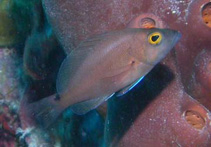| Family: |
Serranidae (Sea basses: groupers and fairy basslets) |
| Max. size: |
9.05 cm SL (male/unsexed) |
| Environment: |
reef-associated; marine; depth range 2 - 12 m |
| Distribution: |
Western Atlantic: Nicaragua, Mexico, Florida Keys, Grand Cayman, the Dominican Republic, Venezuela, Bonaire and Tobago. |
| Diagnosis: |
Dorsal spines (total): 10-10; Dorsal soft rays (total): 15-15; Anal spines: 3-3; Anal soft rays: 7-7; Vertebrae: 24-24. This species is distinguished from all named congeners by colouration by the following characters: body and dorsal fin are brown, no dark vertical bars, pelvic fins are bright smoky blue and anal fin ranges from smoky blue to brown with smoky blue tones; lips are smoky blue and the iris is yellow; most similarly coloured, unbarred hamlets are H. randallorum, H. chlorurus, H. nigricans, H. atlahua, which differ most from H. affinis in the ground colour of the body (lighter (tan) in H. randallorum which also has large dark spots on the caudal peduncle and snout) and darker (black) in H. chlorurus, H. nigricans, H. atlahua, plus H. chlorurus has yellow pectoral and caudal fins (Ref. 125712). |
| Biology: |
Found in reef areas, with its foraging behaviour suggesting that like the other hamlets, it is a mesopredator. In Bocas del Toro and Guna Yala (Panama), it has been observed at depths
ranging from 2 to 12 m. |
| IUCN Red List Status: |
Not Evaluated (N.E.) Ref. (130435)
|
| Threat to humans: |
harmless |
Source and more info: www.fishbase.org. For personal, classroom, and other internal use only. Not for publication.
